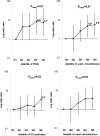Polychlorinated biphenyls and organochlorine pesticides in plasma predict development of type 2 diabetes in the elderly: the prospective investigation of the vasculature in Uppsala Seniors (PIVUS) study
- PMID: 21700918
- PMCID: PMC3142022
- DOI: 10.2337/dc10-2116
Polychlorinated biphenyls and organochlorine pesticides in plasma predict development of type 2 diabetes in the elderly: the prospective investigation of the vasculature in Uppsala Seniors (PIVUS) study
Abstract
Objective: Persistent organic pollutants (POPs), lipophilic chemicals that accumulate mainly in adipose tissue, have recently been linked to type 2 diabetes. However, evidence from prospective studies is sparse. This study was performed to evaluate prospective associations of type 2 diabetes with selected POPs among the elderly.
Research design and methods: Nineteen POPs (14 polychlorinated biphenyl [PCB] congeners, 3 organochlorine pesticides, 1 brominated diphenyl ether, and 1 dioxin) were measured in plasma collected at baseline in 725 participants, aged 70 years, of the Prospective Investigation of the Vasculature in Uppsala Seniors (PIVUS).
Results: After adjusting for known type 2 diabetes risk factors, including obesity, odds ratios (ORs) (95% CIs) for type 2 diabetes at age 75 years (n = 36) according to the quintiles of a summary measure of concentrations of PCBs (vs. the lowest quintile) were 4.5, 5.1, 8.8 (1.8-42.7), and 7.5 (1.4-38.8) (P(trend) <0.01). Among organochlorine pesticides, adjusted ORs across concentrations of trans-nonachlor showed that P(trend) = 0.03. Adjusted ORs (95% CIs) across quintiles of the sum of three organochlorine pesticides were 1.1, 1.6, 1.5, and 3.4 (1.0-11.7) (P(trend) = 0.03). Neither brominated diphenyl ether 47 nor dioxin was significantly associated with incident diabetes. The sum of PCBs improved reclassification significantly when added to traditional risk factors for diabetes.
Conclusions: Despite the small number of incident cases, this study found that environmental exposure to some POPs substantially increased risk of future type 2 diabetes in an elderly population.
Figures

References
-
- Lee DH, Lee IK, Song K, et al. . A strong dose-response relation between serum concentrations of persistent organic pollutants and diabetes: results from the National Health and Examination Survey 1999-2002. Diabetes Care 2006;29:1638–1644 - PubMed
-
- Longnecker MP, Michalek JE. Serum dioxin level in relation to diabetes mellitus among Air Force veterans with background levels of exposure. Epidemiology 2000;11:44–48 - PubMed

